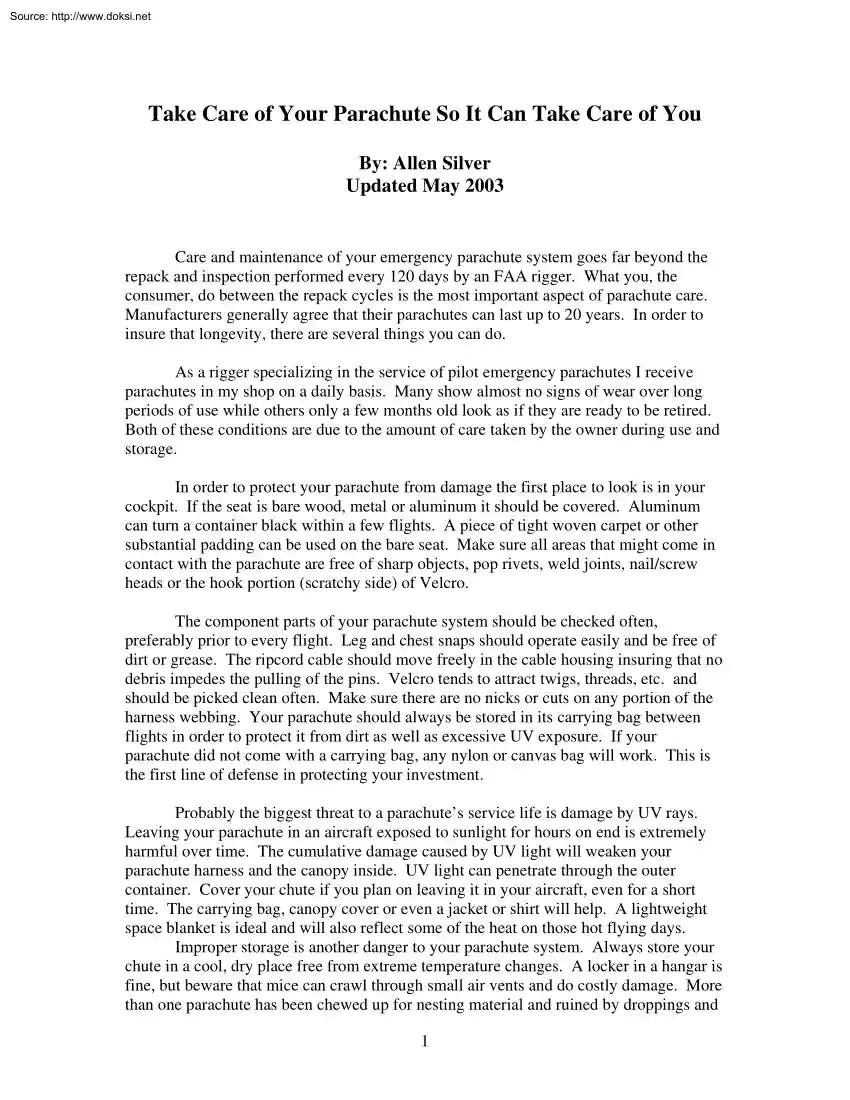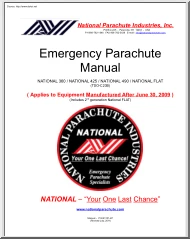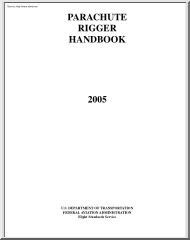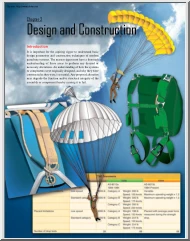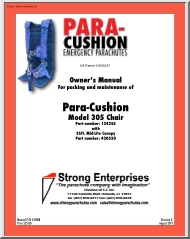Datasheet
Year, pagecount:2003, 4 page(s)
Language:English
Downloads:2
Uploaded:February 28, 2019
Size:464 KB
Institution:
-
Comments:
Attachment:-
Download in PDF:Please log in!
Comments
No comments yet. You can be the first!Content extract
Source: http://www.doksinet Take Care of Your Parachute So It Can Take Care of You By: Allen Silver Updated May 2003 Care and maintenance of your emergency parachute system goes far beyond the repack and inspection performed every 120 days by an FAA rigger. What you, the consumer, do between the repack cycles is the most important aspect of parachute care. Manufacturers generally agree that their parachutes can last up to 20 years. In order to insure that longevity, there are several things you can do. As a rigger specializing in the service of pilot emergency parachutes I receive parachutes in my shop on a daily basis. Many show almost no signs of wear over long periods of use while others only a few months old look as if they are ready to be retired. Both of these conditions are due to the amount of care taken by the owner during use and storage. In order to protect your parachute from damage the first place to look is in your cockpit. If the seat is bare wood, metal or aluminum it
should be covered Aluminum can turn a container black within a few flights. A piece of tight woven carpet or other substantial padding can be used on the bare seat. Make sure all areas that might come in contact with the parachute are free of sharp objects, pop rivets, weld joints, nail/screw heads or the hook portion (scratchy side) of Velcro. The component parts of your parachute system should be checked often, preferably prior to every flight. Leg and chest snaps should operate easily and be free of dirt or grease. The ripcord cable should move freely in the cable housing insuring that no debris impedes the pulling of the pins. Velcro tends to attract twigs, threads, etc and should be picked clean often. Make sure there are no nicks or cuts on any portion of the harness webbing. Your parachute should always be stored in its carrying bag between flights in order to protect it from dirt as well as excessive UV exposure. If your parachute did not come with a carrying bag, any nylon or
canvas bag will work. This is the first line of defense in protecting your investment. Probably the biggest threat to a parachute’s service life is damage by UV rays. Leaving your parachute in an aircraft exposed to sunlight for hours on end is extremely harmful over time. The cumulative damage caused by UV light will weaken your parachute harness and the canopy inside. UV light can penetrate through the outer container. Cover your chute if you plan on leaving it in your aircraft, even for a short time. The carrying bag, canopy cover or even a jacket or shirt will help A lightweight space blanket is ideal and will also reflect some of the heat on those hot flying days. Improper storage is another danger to your parachute system. Always store your chute in a cool, dry place free from extreme temperature changes. A locker in a hangar is fine, but beware that mice can crawl through small air vents and do costly damage. More than one parachute has been chewed up for nesting material and
ruined by droppings and 1 Source: http://www.doksinet urine. You might consider purchasing a plastic Tupper Ware type container with a lid Placing desiccants in the container will help absorb moisture. Keep your parachute away from heat sources, such as water heaters, furnaces, washers or dryers. If storing your chute in the vicinity of any of these items, always keep it off the floor to prevent water damage in the event of a leak. The trunk of your car can reach extremely high temperatures. Over time prolonged storage in your trunk will accelerate deterioration of the fabric. Make sure that any battery acid from jumper cables or batteries is no where near your parachute. Acid residue can be instant death to your nylon parachute. Parachute material will deteriorate over time by itself even when properly stored. Don’t accelerate this by improper storage Humidity and dampness can cause severe, irreparable damage to the parachute if not repacked according to FAA regulations. Mold may
appear which, gone unnoticed, can require major repairs or worse. More importantly humidity can hasten the breakdown and sometimes meltdown of the rubber bands used to retain the lines of your parachute. Unfortunately, I have condemned out many parachutes ruined by rubber bands stuck to the lines and canopy after being unopened for months or years. There is just no way to remove them. Once this happens the entire mess is often stuck to the inside of your container preventing your parachute from opening properly. If you are lucky, you will discover this during a repack, not a bailout. If you live in a high humidity climate, I strongly urge you to strictly follow the FAA requirements of servicing your parachute every 120 days. If you intend not to use your parachute for six months or more, I recommend the following procedure for prolonged storage. Open the parachute container and remove the lines from the rubber bands. Take care not to snag the lines on any Velcro on the container Remove
the rubber bands from the container and throw them away. Put the canopy in a large plastic bag separate from the container to prevent the Velcro from damaging the lines and fabric. If you ship your parachute to a rigger for servicing, you can pull the ripcord at home for practice. Don’t stand too close to your priceless heirlooms because the pilot chute should fly out several feet. Box it up using the guidelines above Use a good box that the chute will fit into tightly. Do not put Styrofoam chips, shredded paper or wood chips into the packing box. It could get into and block the ripcord cable housing Most riggers will holler at you because of the mess and many will charge you to clean the material of your parachute. Styrofoam chips also have a lot of static electricity and are especially difficult to remove. If you must use this type of packing material place it first in a separate bag and seal it tightly to prevent leakage. The FAA certifies two rankings of parachute riggers. A
senior rigger can do repack, spot-clean your parachute and replace elastic keepers or hand-tackiness that may have come loose. Only minor repairs that do not affect the structural integrity of your parachute can be performed by a senior rigger. Any other repairs, which do affect the structural integrity of a parachute (including changing connector links) must be done by a master rigger. In order to be certified as a master rigger, a minimum of three years experience is required. Any rigger working on your parachute should have access to the 2 Source: http://www.doksinet proper manual for your particular parachute and all the equipment/tools necessary to do the job properly. This includes sewing machines or any other special tools needed Parachute riggers have an FAA issued license that looks like your pilot’s license. It will say if they are a senior or master rigger and what parachutes they are rated to pack (seat, back or chest). Don’t be afraid to ask to see it Any rigger
worth their salt will gladly show you their license. As a master rigger, I correlate a regular repack and inspection cycle to an annual on your aircraft. It’s preventative maintenance If there are Ad’s or factory service bulletins on your chute, the work can be done on a timely basis. Often, I recommend upgrading an older parachute with factory improvements that appear on newer models. It could be an improved steering system or using four connector links instead of two. These items may not be critical to the proper functioning of your chute, but even the slightest upgrade may enhance your chances of survival in an emergency. Doing your own parachute rigging can backfire costing you money and possibly your life. I once received a parachute with a home sewing job The person had sewn the canopy to the inside of the container! I don’t think the parachute would have opened. I’ve seen snaps replaced with non-certified replacements or modified in such a manner they would have failed
during opening shock. Do not wrap any kind of tape around webbing to secure loose ends. All adhesive will eventually deteriorate nylon Occasionally, I receive a parachute whose owner has glued some padding to the harness or container. Glue will also eat up the fibers over time Please consult your rigger before using any home remedies. They’ve been properly trained to care for your expensive cushion. My goal is that your state-of-the-art emergency parachute will last up to 20 years and be an effective life saving device should the need arise. The vast majority of pilots will never need their parachute to save their lives. Proper care and maintenance will help assure a positive outcome in the rare event of an emergency bailout. Always practice your emergency drills before and after each flight to keep everything fresh in your mind. I strongly recommend wearing a rigid helmet on all flights. If your wing snaps off and your head impacts the inside of the aircraft rendering you
unconscious, having a properly maintained parachute is a moot point. When considering the purchase of a new aircraft, take your parachute and helmet to see if their is room for both in the cockpit. You should also consider wearing Nomex flightsuits and gloves as added protection, in the event of an onboard fire. Please check out my other safety articles on my website at: www.SilverParachutescom I’m always available for safety seminars providing in depth emergency bailout procedures. You can also call or e-mail me with your questions My shop hours are Monday-Thursday, 8:30am–5pm (pst). Remember, there is no excuse for putting your safety at risk with an improperly maintained parachute. 3 Source: http://www.doksinet Thank you, Allen Silver 510-785-7070 Allen@SilverParachutes.com 4
should be covered Aluminum can turn a container black within a few flights. A piece of tight woven carpet or other substantial padding can be used on the bare seat. Make sure all areas that might come in contact with the parachute are free of sharp objects, pop rivets, weld joints, nail/screw heads or the hook portion (scratchy side) of Velcro. The component parts of your parachute system should be checked often, preferably prior to every flight. Leg and chest snaps should operate easily and be free of dirt or grease. The ripcord cable should move freely in the cable housing insuring that no debris impedes the pulling of the pins. Velcro tends to attract twigs, threads, etc and should be picked clean often. Make sure there are no nicks or cuts on any portion of the harness webbing. Your parachute should always be stored in its carrying bag between flights in order to protect it from dirt as well as excessive UV exposure. If your parachute did not come with a carrying bag, any nylon or
canvas bag will work. This is the first line of defense in protecting your investment. Probably the biggest threat to a parachute’s service life is damage by UV rays. Leaving your parachute in an aircraft exposed to sunlight for hours on end is extremely harmful over time. The cumulative damage caused by UV light will weaken your parachute harness and the canopy inside. UV light can penetrate through the outer container. Cover your chute if you plan on leaving it in your aircraft, even for a short time. The carrying bag, canopy cover or even a jacket or shirt will help A lightweight space blanket is ideal and will also reflect some of the heat on those hot flying days. Improper storage is another danger to your parachute system. Always store your chute in a cool, dry place free from extreme temperature changes. A locker in a hangar is fine, but beware that mice can crawl through small air vents and do costly damage. More than one parachute has been chewed up for nesting material and
ruined by droppings and 1 Source: http://www.doksinet urine. You might consider purchasing a plastic Tupper Ware type container with a lid Placing desiccants in the container will help absorb moisture. Keep your parachute away from heat sources, such as water heaters, furnaces, washers or dryers. If storing your chute in the vicinity of any of these items, always keep it off the floor to prevent water damage in the event of a leak. The trunk of your car can reach extremely high temperatures. Over time prolonged storage in your trunk will accelerate deterioration of the fabric. Make sure that any battery acid from jumper cables or batteries is no where near your parachute. Acid residue can be instant death to your nylon parachute. Parachute material will deteriorate over time by itself even when properly stored. Don’t accelerate this by improper storage Humidity and dampness can cause severe, irreparable damage to the parachute if not repacked according to FAA regulations. Mold may
appear which, gone unnoticed, can require major repairs or worse. More importantly humidity can hasten the breakdown and sometimes meltdown of the rubber bands used to retain the lines of your parachute. Unfortunately, I have condemned out many parachutes ruined by rubber bands stuck to the lines and canopy after being unopened for months or years. There is just no way to remove them. Once this happens the entire mess is often stuck to the inside of your container preventing your parachute from opening properly. If you are lucky, you will discover this during a repack, not a bailout. If you live in a high humidity climate, I strongly urge you to strictly follow the FAA requirements of servicing your parachute every 120 days. If you intend not to use your parachute for six months or more, I recommend the following procedure for prolonged storage. Open the parachute container and remove the lines from the rubber bands. Take care not to snag the lines on any Velcro on the container Remove
the rubber bands from the container and throw them away. Put the canopy in a large plastic bag separate from the container to prevent the Velcro from damaging the lines and fabric. If you ship your parachute to a rigger for servicing, you can pull the ripcord at home for practice. Don’t stand too close to your priceless heirlooms because the pilot chute should fly out several feet. Box it up using the guidelines above Use a good box that the chute will fit into tightly. Do not put Styrofoam chips, shredded paper or wood chips into the packing box. It could get into and block the ripcord cable housing Most riggers will holler at you because of the mess and many will charge you to clean the material of your parachute. Styrofoam chips also have a lot of static electricity and are especially difficult to remove. If you must use this type of packing material place it first in a separate bag and seal it tightly to prevent leakage. The FAA certifies two rankings of parachute riggers. A
senior rigger can do repack, spot-clean your parachute and replace elastic keepers or hand-tackiness that may have come loose. Only minor repairs that do not affect the structural integrity of your parachute can be performed by a senior rigger. Any other repairs, which do affect the structural integrity of a parachute (including changing connector links) must be done by a master rigger. In order to be certified as a master rigger, a minimum of three years experience is required. Any rigger working on your parachute should have access to the 2 Source: http://www.doksinet proper manual for your particular parachute and all the equipment/tools necessary to do the job properly. This includes sewing machines or any other special tools needed Parachute riggers have an FAA issued license that looks like your pilot’s license. It will say if they are a senior or master rigger and what parachutes they are rated to pack (seat, back or chest). Don’t be afraid to ask to see it Any rigger
worth their salt will gladly show you their license. As a master rigger, I correlate a regular repack and inspection cycle to an annual on your aircraft. It’s preventative maintenance If there are Ad’s or factory service bulletins on your chute, the work can be done on a timely basis. Often, I recommend upgrading an older parachute with factory improvements that appear on newer models. It could be an improved steering system or using four connector links instead of two. These items may not be critical to the proper functioning of your chute, but even the slightest upgrade may enhance your chances of survival in an emergency. Doing your own parachute rigging can backfire costing you money and possibly your life. I once received a parachute with a home sewing job The person had sewn the canopy to the inside of the container! I don’t think the parachute would have opened. I’ve seen snaps replaced with non-certified replacements or modified in such a manner they would have failed
during opening shock. Do not wrap any kind of tape around webbing to secure loose ends. All adhesive will eventually deteriorate nylon Occasionally, I receive a parachute whose owner has glued some padding to the harness or container. Glue will also eat up the fibers over time Please consult your rigger before using any home remedies. They’ve been properly trained to care for your expensive cushion. My goal is that your state-of-the-art emergency parachute will last up to 20 years and be an effective life saving device should the need arise. The vast majority of pilots will never need their parachute to save their lives. Proper care and maintenance will help assure a positive outcome in the rare event of an emergency bailout. Always practice your emergency drills before and after each flight to keep everything fresh in your mind. I strongly recommend wearing a rigid helmet on all flights. If your wing snaps off and your head impacts the inside of the aircraft rendering you
unconscious, having a properly maintained parachute is a moot point. When considering the purchase of a new aircraft, take your parachute and helmet to see if their is room for both in the cockpit. You should also consider wearing Nomex flightsuits and gloves as added protection, in the event of an onboard fire. Please check out my other safety articles on my website at: www.SilverParachutescom I’m always available for safety seminars providing in depth emergency bailout procedures. You can also call or e-mail me with your questions My shop hours are Monday-Thursday, 8:30am–5pm (pst). Remember, there is no excuse for putting your safety at risk with an improperly maintained parachute. 3 Source: http://www.doksinet Thank you, Allen Silver 510-785-7070 Allen@SilverParachutes.com 4
